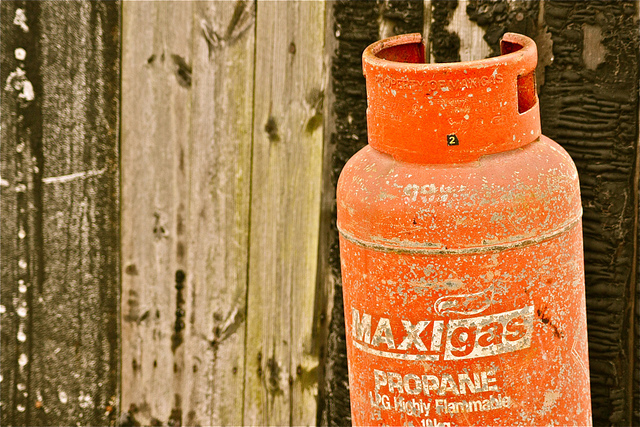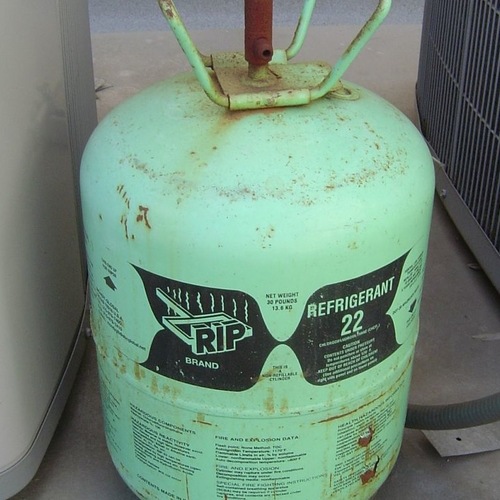
Image Credit: Barkaw - from Flickr.com
“A New Zealand technician got fire balled in the face,” a member of the HVAC-talk.com forum stated bluntly. He was referring to a case in New Zealand where an HVAC tech got burned when he thought he was working on a system with R-22 refregerant, which is not flammable, but which instead was filled with propane, which is flammable.
The latest turn in the story on the phase-out of R-22 air conditioner refrigerant is the use of unapproved substitutes for R-22. You can go online and find a lot of them. They have different labels—R-22a, 22-A, HC-22a, CARE 40, and more. The advantage they have that’s given them some traction in the marketplace is that they’re cheaper than R-22, which has become really expensive because it’s being phased out.
Propane in your air conditioner?
Yes, some HVAC companies are putting propane, isobutane, and various other mixtures in air conditioners. There’s nothing inherently wrong with using hydrocarbons as refrigerants. They’re actually approved for use in some refrigeration systems. One of their benefits is having a low global warming potential, especially compared to the standard refrigerants (HCFCs and HFCs).
In fact, the Treehugger website had an article praising the US Environmental Protection Agency’s decision to allow them in refrigerators a couple of years ago. One advantage is higher heat capacities, which allows for smaller compressors and coils, less refrigerant, and higher efficiency. According to that article, “Hydrocarbon refrigerants also take less energy to make and have no toxic inputs during manufacture, are dirt cheap (pennies instead of dollars per pound) and do not require expensive and tricky recovery operations at end of product life.”
The problems with R-22 substitutes
Despite the benefits of hydrocarbon refrigerants, they’re being used in ways that just aren’t smart. The two main problems are: (1) Air conditioners designed for R-22 and retrofitted with hydrocarbon refrigerants are dangerous to service technicians who aren’t aware of the substitution; and (2) air conditioners designed for R-22 often can’t handle hydrocarbon refrigerants.
The EPA this month issued a news release about the dangers of unapproved refrigerants. “EPA is aware of incidents that have occurred both overseas and in the U.S. where individuals have been injured as a result of the use of propane and other unapproved refrigerants in air conditioning systems.”
The incident in New Zealand may be one of those. Anyone who puts hydrocarbon refrigerants in an R-22 system is putting others at risk. Even if they label it, the chances are still too high that some tech will come in later, see what looks like an R-22 system, miss the new labeling, and get the surprise of their life when they discover they’re working with flammable refrigerant.
As if the threat of injury weren’t enough, propane and other R-22 subsititutes have equipment problems when used in systems designed for R-22. The Lennox page on alternative refrigerants lists these additional pitfalls for their equipment:
- Alternate refrigerants are NOT compatible with mineral oil. All Lennox and Aire-Flo nitrogen-charged “dry” units contain mineral oil lubricant. Using alternative refrigerants to service R-22 mineral oil units can have detrimental effects on the operation of the unit.
- The use of alternate refrigerant in systems containing mineral oil as their lubricant voids the manufacturer and compressor warranty.
- The use of alternate refrigerants in other R-22 systems containing polyester oil (POE) can lead to performance loss (capacity and energy efficiency), temperature glide variations, and some combinations will be more detrimental to the environment than R-22.
When I was searching for info on the subsitutes, I came across sellers of R-22A who promote their products by saying you don’t need a license to buy and use it. The last thing the HVAC industry needs is more unlicensed activity.
The Air Conditioning Contractors of America (ACCA) also came out with an article about R-22 substitutes and the EPA news release. “Hydrocarbon refrigerants pose a special hazard for HVAC contractors unaware of their presence in a system.”
How low will we stoop?
R-22 is being phased out because of damage to the ozone layer in the stratosphere. It was the first replacement for the earlier freons, which were really destructive and banned by the Montreal Protocol in 1987. (Read about the science here.) The phase-out of R-22 has been planned since the ’90s.
The first wave of skirting the phase-out of R-22 refrigerant was using a loophole that allowed manufacturers to deliver what came to be known as “dry-ship R-22 units.” I wrote about this last year, shortly after I became aware of it.
Now, the use of flammable R-22 substitutes like R-22a, claimed to be outside any licensing requirements, takes things to a new low. Not only are HVAC companies that do this skirting the law by using unapproved refrigerants, they’re also creating the potential for greater cost to their customers and causing injury or death to HVAC techs who work on those systems later. As I said above, though, it’s not the refrigerants themselves; it’s the “cowboy” mentality of some contractors.
Maybe we’ll have air conditioners designed for hydrocarbon refrigerants some day. Currently we do not. In the interim, do you really want to take a chance with unapproved refrigerants?
Allison Bailes of Decatur, Georgia, is a speaker, writer, energy consultant, RESNET-certified trainer, and the author of the Energy Vanguard Blog. You can follow him on Twitter at @EnergyVanguard.
Weekly Newsletter
Get building science and energy efficiency advice, plus special offers, in your inbox.












4 Comments
The refrigerant characteristics of propane...
...are so CLOSE to those of R22 that I understand temptation to use it, since it can usually be functional & efficient as a drop-in replacement, no system tweaks necessary. Propane has nearly three orders of magnitude lower global warming potential (GWP) than R22 or R410A (the current dominant refrigerant out there) too. It's that pesky flammability issue that keeps it from becoming a standard refrigerant, even in newer heat pump systems.
CO2 is a pretty-good refrigerant with none of the ozone/GWP/flammability issues of R22/R410A/propane, but requires much higher pressures and more complex & expensive multi-stage compressors. It's making some inroads and may eventually become a dominant refrigerant in many applications (including hydronic-output space & water heating heat pumps), but SFAIK none are available in N. America (yet.) Sanyo has a fairly efficient 4.5kw & 9kw output CO2 refrigerant hydronic space heating units that have been marketed in Europe and Asia for several years now, but on the small size for the actual heat loads of existing homes in cooler US climate zones (and almost all of Canada), but within the heat load of many better-than code or smaller homes.
That 9kw figure is about 31,000BTU/hr, which is about the output of a standalone gas-fired hot water heater. In a recent-years utility survey the estimated average heat load across all existing homes in Massachusetts (US climate zone 5) is about 14kw, and many new code min homes could be heated with the 9kw Sanyo, but it's simply not available here, then there's the air conditioning issue, so obvious this week in MA. But IIRC now that HFC134a has been banned as an automotive AC refrigerant in Europe (due to the sky-high GWP factor), some auto manufacturers are switching over to CO2 refrigerant despite the more expensive compressors. See:
http://www.marklines.com/en/report/rep614_200710
http://www.theicct.org/sites/default/files/publications/ICCT_refrigerant_workingpaper_2011_0.pdf
Given their very high GWP, the most common low-ozone-depletion refrigerants currently in use will very likely be banned in the coming decade or two. Hopefully that won't orphan the large installed base of R410A refrigerant equipment when it happens, with unintended consequences comparable to the propane-as-R22 problem.
Response to Dana Dorsett
Thanks for the additional info on CO2 as a refrigerant, Dana. The issue of refrigerants is complex and expensive, with huge ramifications industry-wide, from manufacturers to the one-person HVAC companies. It'll definitely be interesting to see how things shake out over the next decade as R-22 makes its exit. I also hope that R-410A doesn't get orphaned, since I have a fairly new heat pump using the stuff in our condo.
I too would like to see more on CO2 compressors & R410A subs.
CO2 has a lot in it's favor, but for the compressor complexity/cost issue. I'm glad the VDA pushed forward on that front (it's - if it becomes the standard in Europe it's likely to become the international standard, and the compressor designs will evolve. I suspect most of the HFC134a leakage in the world is from automotive AC, which aren't exactly known for high retention rates of the refrigerant, and just as it's use in blowing XPS foam, that's something of a no-brainer thing to get away from.
For a quick academic discussion of propane vs. R22 See: http://docs.lib.purdue.edu/cgi/viewcontent.cgi?article=2086&context=icec
R410A isn't so different from R22 either, and I'm sure somebody out there has (for yuks or out of desperation) already charged an R410A system with propane.
As I understand it one of the critical factors to consider when switching to hydrocarbon refrigerants is the higher miscibility of the lubricants (per your Lennox references) in the liquid hydrocarbon, which varies depending on the exact lubricants used. It's sort of like using a thinning solvent in the lubricant, giving it a lower viscosity. Backyard reefer-techs and bootleggers probably aren't paying too close attention to those issues and probably don't have access to the necessary information even if they knew what to do with it. But I suspect most of the time they do just fine, at least for awhile... There are known lubricants used in refrigeration systems that are compatible with both R22 and propane, but that's not to say that any given system uses a compatible lubricant, and most that have been dialed-in for optimal long term use & wear with R22 probably won't be the ideal (even if OK) viscosity for long term use with propane. It's analogous to using SAE 5W motor oil in a car engine designed for SAE 20W- it won't crap out right away, may even last a long time, but it's not best practice, and it may even leak some at the seals.
To be sure, propane seems a likely refrigerant for use in automotive AC systems, provided the seals, compressors, & tubing are all designed for propane refrigerant. It's not very different from HFC134a, either, but has a GWP of about 3 (as opposed to about 1300.) But the potential for flammable or even explosive mixtures occurring in the event of a breach during an accident probably keeps it out of contention. But the energy density and total volume of the hazard seems comparatively small compared to the gasoline leaks present in car crashes.
OTOH Honeywell has been lobbyine heavily for their HFO-1234yf refrigerant as a cheaper-than-CO2-compressor refrigerant for auto AC, and it may very well win the day for the world market, but it too is flammable, though probably not as flammable as propane: http://www.sae.org/standardsdev/tsb/cooperative/executivesummary.pdf Prior estimates of it's GWP have been as high as 4, but just this week Honeywell has claimed a GWP of less than 1 (lower than CO2): http://www.racplus.com/news/hfo-1234yf-refrigerant-actually-has-a-global-warming-potential-of-less-than-1-honeywell-announces/8650845.article
To be sure, high GWP refrigerants are clearly in the sights of regulators and manufacturers alike- here WILL be better stuff available very soon. Whether they'll be solutions that work in existing R22 or R410a heat pumps without problems remains to be seen. The economic incentive for getting to a compatible solution is high, but to date elusive in the R22 case.
Of course the Holy Grail...
would be a complete shift away from vapor compression refrigeration.
Log in or create an account to post a comment.
Sign up Log in